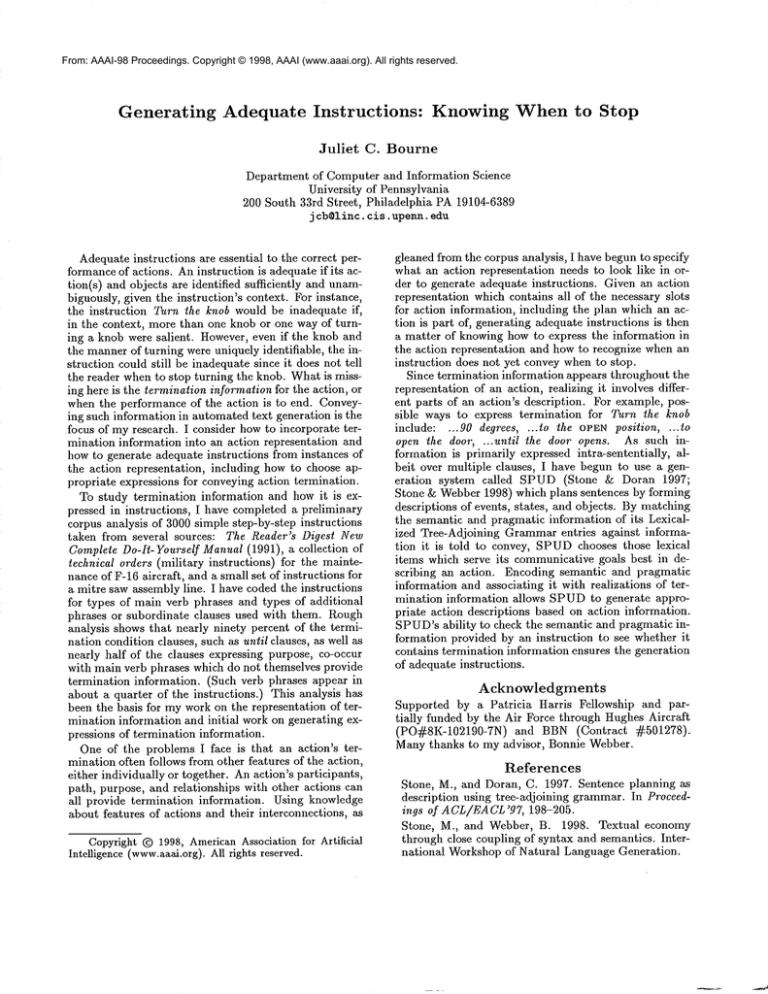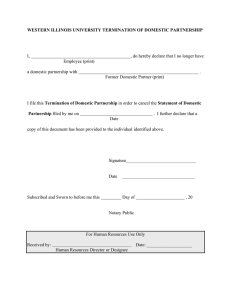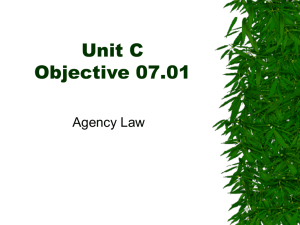
From: AAAI-98 Proceedings. Copyright © 1998, AAAI (www.aaai.org). All rights reserved.
Generating
Adequate
Instructions:
Juliet
C.
Knowing When to Stop
Bourne
Department of Computer and Information Science
University of Pennsylvania
200 South 33rd Street, Philadelphia PA 19104-6389
j cb@linc,
cis.upenn,edu
Adequate instructions are essential to the correct performance of actions. An instruction is adequate if its action(s) and objects are identified sufficiently and unambiguously, given the instruction’s context. For instance,
the instruction
Turn the knob would be inadequate if,
in the context, more than one knob or one way of turning a knob were salient. However, even if the knob and
the manner of turning were uniquely identifiable,
the instruction could still be inadequate since it does not tell
the reader when to stop turning the knob. What is missing here is the termination information for the action, or
when the performance of the action is to end. Conveying such information in automated text generation is the
focus of my research. I consider how to incorporate termination information into an action representation
and
how to generate adequate instructions from instances of
the action representation,
including how to choose appropriate expressions for conveying action termination.
To study termination information and how it is expressed in instructions,
I have completed a preliminary
corpus analysis of 3000 simple step-by-step instructions
taken from several sources: The Reader’s Digest New
Complete Do-It-Yourself Manual (1991), a collection
technical orders (military instructions)
for the maintenance of F-16 aircraft, and a small set of instructions for
a mitre saw assembly line. I have coded the instructions
for types of main verb phrases and types of additional
phrases or subordinate clauses used with them. Rough
analysis shows that nearly ninety percent of the termination condition clauses, such as until clauses, as well as
nearly half of the clauses expressing purpose, co-occur
with main verb phrases which do not themselves provide
termination information. (Such verb phrases appear in
about a quarter of the instructions.)
This analysis has
been the basis for my work on the representation of termination information and initial work on generating expressions of termination information.
One of the problems I face is that an action’s termination often follows from other features of the action,
either individually or together. An action’s participants,
path, purpose, and relationships
with other actions can
all provide termination information.
Using knowledge
about features of actions and their interconnections, as
Copyright (~) 1998, AmericanAssociation for Artificial
Intelligence (www.aaai.org). All rights reserved.
gleaned from the corpus analysis, I have begun to specify
what an action representation needs to look like in order to generate adequate instructions.
Given an action
representation which contains all of the necessary slots
for action information, including the plan which an action is part of, generating adequate instructions is then
a matter of knowing how to express the information in
the action representation
and how to recognize when an
instruction does not yet convey when to stop.
Since termination information appears throughout the
representation of an action, realizing it involves different parts of an action’s description. For example, possible ways to express termination
for Turn the knob
include: ...90 degrees, ...to the OPENposition, ...to
open the door, ...until
the door opens. As such information is primarily expressed intra-sententially,
albeit over multiple clauses, I have begun to use a generation
system called SPUD (Stone &= Doran 1997;
Stone & Webber 1998) which plans sentences by forming
descriptions of events, states, and objects. By matching
the semantic and pragmatic information of its Lexicalized Tree-Adjoining Grammar entries against information it is told to convey, SPUDchooses those lexical
items which serve its communicative goals best in describing an action. Encoding semantic and pragmatic
information and associating it with realizations of termination information allows SPUDto generate appropriate action descriptions based on action information.
SPUD’s ability to check the semantic and pragmatic information provided by an instruction to see whether it
contains termination information ensures the generation
of adequate instructions.
Acknowledgments
Supported by a Patricia
Harris Fellowship and partially funded by the Air Force through Hughes Aircraft
(PO#8K-102190-7N)
and BBN (Contract
#501278).
Many thanks to my advisor, Bonnie Webber.
References
Stone, M., and Doran, C. 1997. Sentence planning as
description using tree-adjoining
grammar. In Proceedings of ACL/EACL’97, 198-205.
Stone, M., and Webber, B. 1998. Textual economy
through close coupling of syntax and semantics. International Workshop of Natural Language Generation.



